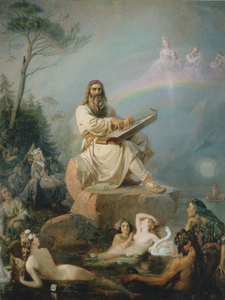
Väinämöisen soitto (Väinämöinen's playing) by R. W. Ekman (1866) portrays Päivätär and Kuutar or other luonnotars sitting on a rainbow.
Päivätär and Kuutar are luonnotars (feminine personifications of nature) or goddesses of the Sun and the Moon in Finnish mythology. They own the gold of the Moon and the silver of the Sun, spin golden and silver yarns, and weave clothes out of them.[1] In Kalevala, young maidens ask Päivätär and Kuutar to give them some of their golden and silver jewellery and clothes.
Both luonnotars are mentioned in Finnish[2][3][4] folk poetry but there is little information of them. Päivätär and Kuutar are emuus (origin mothers) of bees, wasps and hornets and appear in spells that were sung in order to prevent these insects from stinging.[1][2] There is also one spell from Finnish Karelia that states that the world tree grew from the golden and silver tears of Kuutar and Päivätär[5]:
- "--Kuutar itki kultiahan, / Päivätär hopehiahan, / vierahti vesipisara, / kaunihille kasvollensa, / kaunihilta kasvoltahan, / riveälle rinnallensa, / tuosta vierähti norohon; / tuosta kasvoi kaunis tuomi, / yleni rutimon raita--".
- "--Kuutar cried her gold, / Päivätär her silver, / a droplet rolled, / on her beautiful face, / from her beautiful face, / to her [??] chest, / from there it rolled into a rivulet; / from that grew a beautiful bird cherry, / rose an iron trunk--"
Professor Anna-Leena Siikala finds it possible that Päivätär was a kind of goddess who ruled over life and light. During Christian period, she was replaced by Virgin Mary.[6] For instance, there are poems which refer to Virgin Mary as the mother of bees. The influences could've also gone to the other direction, as it is possible that Päivätär got features from the depictions of Mary on church walls. Much like with other luonnotars, Kuutar and Päivätär are more like etiological creatures, which nobody has claimed to have met, nor is there any proof of them having been worshipped.[1]
The name "Päivätär" originates from the word päivä (Eastern Finnish "sun"), which derives from Proto-Uralic *päiwä. "Kuutar" comes from from kuu ("moon"), from Proto-Uralic *kuŋe. -tar/-tär is a feminine suffix.
The poem which tells the origin of fire mentions a female figure called Auringotar as the creator of fire, in the same sentence as it refers to Päivätär as such.[3] Meaning-wise, the name is identical to Päivätär, as both päivä and aurinko mean the Sun (aurinko being the Western Finnish word). It could be two different names for the same being.
Sources[]
- ↑ 1.0 1.1 1.2 Pulkkinen, Risto & Lindfors, Stina. Suomalaisen kansanuskon sanakirja. Gaudeamus (2016). Pages: 159, 191, 294-295.
- ↑ 2.0 2.1 Ampijaisen lumonta. SKVR XII2 4788.
- ↑ 3.0 3.1 Tuli. SKVR XII1 4592.
- ↑ https://skvr.fi/poem/skvr12152670. SKVR XII2 5267.
- ↑ Toukan synty. SKVR VII5 4197.
- ↑ Kauhanen, Erkki. Samaaninen Suomessa hyöri jumalia luonnon täydeltä. (2003)